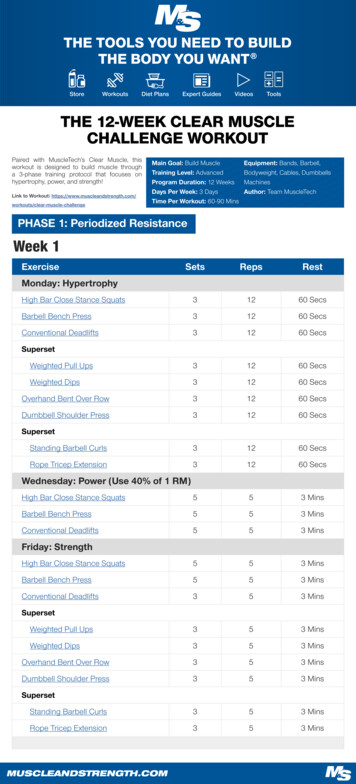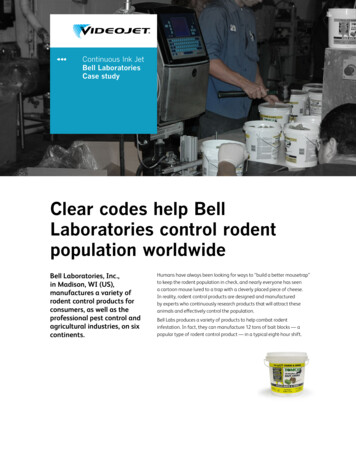
Transcription
Your Guide toCLEAR WRITING
Your Guide to Clear WritingWhen you’re creating educational materials about public health, the most important thingyou can do is to write clearly. This helps make sure readers can understand your mainmessage — and any related action steps you’re asking them to take.Keep in mind that clear writing is important for everyone — not just audiences that are likelyto have limited literacy skills. The fact is that even highly literate readers may struggle tounderstand complex information if they’re stressed or in a hurry. That’s why the need forclear communication is universal — and it’s your job as a public health professional to makesure you do your part.This guide has resources to help you write clear public health materials at every stage ofdevelopment — from tips for thinking through your material’s strategy before you startto write all the way through the final review process. Use the tip sheets, checklists, andworksheets to create clear, effective materials that everyone can understand and use.And for more tips and tools on clear writing, be sure to check out the rest of the resources onthe NCEH/ATSDR Clear Writing Hub.2
Table of ContentsBefore You Write: Answer 4 Key Questions . 48 Tips for Clear and Effective Writing. 8Writing Models.11Clear Writing Checklist and Supporting Information .22Communicating About Amount and Units of Measure.31Plain Language Tip Sheet for Reviewers.36Testing Your Materials.40Preparing and Writing a Scientific Journal Article .45LinkTo access Your Guide to Clear Writing online, lear-writing-guide-508.pdf3
Before You WriteUse the tips below before you begin drafting your material. Just a littlepreparation will help you create a clear, effective product.Answer 4 Key QuestionsBefore you begin writing, answer 4 important questions. You’re not ready to start draftingcontent until you’ve written down clear answers to all 4 of these questions:1. Who is your target audience?2. What do you know about their health literacy skills?3. What is your communication objective?What do you want your readers to do, think, or feel after they read your material?4. What is your main message?What is the most important thing for your readers to remember? They may onlyremember 1 thing — what do you want that to be?Sample Answers to 4 Key Questions1. Parents of young children in Jonesville2. Non-scientific audience with average to low health literacy skills3. Get parents to take their children to the health department for blood lead testing4. Some children in Jonesville have high levels of lead in their blood. This can causelearning and behavior problems. Children living near the study site need to getroutine blood lead tests.Use Your AnswersBe sure to use your answers from all 4 questions as you develop your material.Target AudienceClearly identify your target audience — and get specific. The more you think about who you’retrying to reach, the more you can tailor your content to that audience. Remember to drill down— you want something like “parents of young children in Jonesville,” not “the public.”4
Health Literacy SkillsThink through what you know about your audience’s health literacy skills. Then usethat information to guide your word choice, sentence length, and other plain languageconsiderations. According to the National Assessment of Adult Literacy, almost 9 in 10people struggle to understand health information. So keep it short, simple, and clear:Short: Write sentences that are 20 words or fewer. Limit paragraphs to 3 to 5 sentences.Cut out any words you don’t need.Simple: Avoid jargon and complex technical terms. Define any scientific terms that youneed to include in plain language.Clear: Be straightforward and direct — clearly tell your audience what they need toknow. Always write in the active voice. Keep the subject and verb close together in yoursentences.If you don’t know anything about your audience’s health literacy skills, it’s best toassume they’re average to low. And remember that a person’s reading skills may drop 4grade levels when they’re stressed or reading about a stressful topic.Communication ObjectiveFigure out what you want your audience to think, feel, or do after reading your material. Useyour communication objective to guide decisions about what information to include in yourmaterial — and, more importantly, what to leave out. Remember, the more you write, the lessthey’ll read. Only include content that helps you reach your communication objective.Main MessageWrite a short, clear main message and highlight it. Aim for 1 to 3 short sentences. This helpsyour readers quickly and easily understand the most important information in your material.It also gives readers context for how to interpret the material.Place the main message at or near the top of your material. Make it stand out — use boldtext, color blocking, or a larger font. Note that this material has a clearly visible main messageat the top. Here’s another example of an effective main message: ATSDR found that levelsof chemicals currently in the air from the Baker Landfill aren’t high enough to cause healthproblems.5
Before You Write: Answer 4 Key Questions1. Who is your target audience? Remember to get specific! Always write with this userin mind. Example: Parents of young children in Jonesville Example: Partners who can help us promote a National Health Observance2. What do you know about your audience’s health literacy skills?Now take a few minutes to think through what you know about their health literacy skills. Doyou have any point of reference for literacy and numeracy skills? Health-related conceptsthey might be familiar with? Topics they may have run into before? Jot down some notes. Example: Non-scientific audience with average to low health literacy skills Example: May be a little bit familiar with the topic — this is the second healthassessment in their community Example: May struggle to understand how my data is relevant to them3. What is your communication objective?What do you want your audience to think, feel, or do after reading your material? This shouldbe a single statement — if you think your material has multiple communication objectives,figure out which is the most important (1 of them will be!). Example: Get parents to take their children for blood lead testing Example: Get partners to share our content with their networks6
4. What is your main message?If your readers are going to remember 1 thing after reading your material, what do you wantit to be? Remember, a main message can have a few sentences — but it should be focused ona single concept. Example: Some children in Jonesville have high levels of lead in their blood. This cancause learning and behavior problems. Children living near the study site need to getroutine blood lead tests. Example: Everyone age 6 months and older needs to get a flu vaccine every season.7
8 Tips for Clear& Effective WritingMost readers hate excess words and meandering sentences in any form of writing. Most readersalso hate the bureaucratic jargon we sometimes use in public health (think: “A comprehensiveassessment was conducted prior to implementation of ”).Audiences respond well to logically organized, clearly written, and effectively designed information— regardless of their literacy level or ability to understand complex information. The fact is thatPhD-level scientists appreciate clear writing as much as someone who struggles with readingcomprehension. Clear writing is for every audience and every material.Use the tips below to create clear, effective materials that your readers can understand and use.1Write for Your ReaderIdentify a specific audience and write directly to that audience. Good writers always keeptheir readers in mind. Follow these tips: Keep asking yourself what your target audience needs to know (not what you wantto say). If you have multiple audiences, consider writing multiple materials. Use “you” to connect with your reader.2Change Your StylePublic health writing is all about your audience. It’s not about demonstrating your linguisticmastery. Don’t write to impress your readers — write to reach them. Get right to the pointand remove unnecessary content. And it’s okay to be conversational. Remember to: Use contractions (write “aren’t,” not “are not”). Use pronouns (like “you” and “we”). Use simple words (write “use,” not “utilize”). Be direct (write “analyzed,” not “conducted an analysis”).8
3Spell Out the Main MessageAn effective material has a clear main message. Don’t put the burden on your reader tofigure out the main message — spell it out. Put that clear, succinct main message near thetop of the material. Bold it and highlight it. Stay focused on it. And don’t include content thatdetracts from it.Check out these examples of clear main messages: Everyone 6 months of age and older needs to get a flu vaccine every season. The soil has high levels of lead. This can cause health problems, especially for children.ATSDR recommends blood lead testing for children under age 6 who have come incontact with lead.4Be BriefWe’re bombarded with thousands of messages a day, and this has changed the way we read.Readers tend to skim or scan materials now.Include just the essential information. Remember, the more you write, the less they’ll read.Keep your materials short and to the point: Sentences — no more than 20 words Paragraphs — no more than 5 sentences5Get Back to BasicsThe easiest structure to understand in English is subject verb object. Don’t convolutewriting with complicated grammatical patterns. Remember to: Write in active voice. Keep the subject and verb close together. Use a strong clear verb (when a sentence is unclear, the culprit is often a missing orunclear verb).Check out these examples of clear structure:Passive: About 500 homes were left without water as a result of the chemical spill.Active: The chemical spill left about 500 homes without water.Weak: The training (subject), which was attended by 60 staff members and got over95% approval ratings, was (weak verb) a huge success.Better: The training succeeded: 60 staff members attended and gave approval ratingsof over 95%.9
6Carefully Craft Your Title and SubtitleThe first thing your readers see is your title. It draws them in. And a subtitle can serve as aprimer for what comes next. Carefully craft a title and subtitle using the followingguidelines: Title — no more than 8 words to grab attention Subtitle — no than 1 line to offer more contextCheck out this example of an effective title and subtitle:Instead of: National Safety MonthTry this: Spread the Word About National Safety Month! (title)Learn 5 Ways You Can Make a Difference (subtitle)7Use Meaningful Headlines“Chunk” content into short paragraphs and use lots of meaningful headings — 1 heading forevery 1 to 3 paragraphs is a good rule of thumb.Skip generic headings like “Overview” and “Background.” If readers scan your material andjust read the headings, what do they learn? Use headings to communicate messages (likeshort, bolded topic sentences for the text that follows).Check out these examples of meaningful headings:Weak: IntroductionBetter: CDC Will Study Asthma Triggers in [City, State]Weak: BackgroundBetter: Emergency Room Visits Increase for Asthma Attacks8Pay Attention to DesignDesign elements can help readers understand and remember your messages.Remember to: Use images that reinforce your message. Never use an image that demonstratessomething you don’t want readers to do. Limit lists to no more than 7 bullets. And stay away from sub-bulleted lists. Use call-out boxes or bold for key messages, relevant related information, or contentthat helps spark interest. Make sure there’s plenty of white space.To access Your Guide to Clear Writing online, lear-writing-guide-508.pdf10
Writing ModelsSometimes it’s difficult to organize content into a clear, effectivematerial. Writing models can help. Consider using one of thefollowing models when you’re working on your next writing task,and use the samples for each model to guide you. Check out theHealth Communication Playbook for more ideas and samples.Model 1: StorytellingThis is one clear, effective way to structure success storiesor to deliver a message by presenting it as part of anengaging story. Try to keep stories short (about 800 wordsor fewer).Structure of the Story Title and Subtitle: Write a short title (no more than 8words) to grab your readers’ attention. You can alsochoose to include a subtitle (no longer than 1 line) tooffer more context. Problem: Write 1 to 2 short paragraphs. Start with themost dramatic moment. Explain the problem that youencountered in narrative form.Writing Tips for All Models Limit sentences to nomore than 20 words. Limit paragraphs to nomore than 5 sentences. Use a meaningful headingevery 1 to 3 paragraphs. Keep your materials short— the more you write, theless they’ll read! Intervention: Write 1 to 2 short paragraphs. Describewhat you did. Outcome: Write 1 to 2 short paragraphs. Discuss howyour intervention helped.Storytelling SampleDisease Detectives in EthiopiaCDC Investigates Mystery Illness Spreading Across Northern RegionDisease Spreads to Remote VillagesIn Northern Ethiopia, villagers developed stomach pain and swelling. Some even hadtrouble breathing. In a single household, 3 or 4 people would get sick — while otherswould not. In other families, everyone died from the sickness, but their neighbors didnot. The symptoms were similar to liver disease. What was causing it?TitleSubtitleProblem11
CDC InvestigatesFrom 2005 through 2007, more than 1,200 people were diagnosed with this“unidentified liver disease,” or ULD. Many of them died. In 2007, the EthiopiaMinistry of Health and Ethiopia Health and Nutrition Research Institute (EHNRI)asked CDC and other partners to help look into the outbreak.InterventionA study ruled out infectious diseases as the cause and suggested the disease mightbe related to food. To find out more, scientists sometimes had to walk 4 hours eachway to remote households. Investigators also tested grain samples grown in villages— and they found low levels of a plant-based toxin called pyrrolizidine alkaloids(PAs) in weeds harvested with the grain. Could that have anything to do with theoutbreak?Important Discovery about Separating WeedsFollowing a recommendation from CDC, in 2009, EHNRI created a ULDsurveillance system. CDC developed tools to take medical histories and collectphysical and environmental samples. In 2011, CDC staff returned to Ethiopia andjoined partners to:Interventioncontinued. Visit villages Do physical examinations and ultrasounds Collect blood and urine samples Gather environmental samples for PA testingOf the ULD patients sampled, 50% tested positive for PA. Testing showed thatother family members and villagers had also come in contact with PA, but ULDpatients had higher PA levels. Although households with and without ULD ate anddrank the same foods and beverages, non-ULD households were more likely toseparate the weeds from their crops before and after harvest.Eradicating ULDThe study helped researchers pinpoint the cause of ULD more accurately, butthere’s no cure — so getting rid of the source of PA was the only option. The healthministry began a “zero tolerance” policy for weeds, and EHNRI and health workerstaught householders how to separate weeds from grain. They also encouragedvillagers to check their livestock for ULD symptoms to protect themselves fromcontact with PA through milk or meat.OutcomeThanks to the partners’ skill, knowledge, and persistence, we know the cause ofULD. It’s now called pyrrolizidine alkaloid-induced liver disease, or PAILD. Moreimportantly, grain farmers in Ethiopia can now protect themselves and their familiesfrom this deadly disease.12
Model 2: The Feature ArticleThis model, adapted from Wylie Communications, uses creative and engagingcharacteristics to help you deliver messages in an interesting way. Try to keep featurearticles between 500 and 1000 words.Structure of the Feature Article Title and Subtitle: Write a short title (no more than 8 words) to grab your readers’attention. You can also choose to include a subtitle (no longer than 1 line) to offer morecontext. Lead: Write 1 to 3 short sentences. This is the hook. Be creative — you want to provokeinterest and questions. Nutshell Paragraph: Write 1 to 5 short sentences — include your key message. Background: If necessary, include 1 to 4 short sentences of background information. Body: Write 1 to 3 short paragraphs. Select and focus on just a few points that supportyour key message. And make sure you have a clear organizational pattern for thissection — for example, put your points in hierarchical, chronological, or alphabeticalorder. Use engaging, meaningful headings for each main point — 1 heading every 1 to 3paragraphs is a good rule of thumb. Wrap-Up: Restate your key message.Feature Article SampleBlue Wiener Dog Reveals Common Family DilemmaLearn How to Keep Your Kids Active and Healthy This SummerAs I kicked off my heels and headed toward the bedroom to change out of myoffice clothes, a faint smell of blueberries wafted toward me as Fritz, the familyschnauzer, trotted my way. Once he reached me, he wiggled with that familiarwet-dog shake, spraying blueberry yogurt across the room and all over me.I looked down, and there stood my 7-year-old son, beaming with pride at hisfinger-painting experiment.Before your kids figure out how to turn your kitchen into a slip-n-slide withbutter — or blueberry yogurt — learn ways to keep them busy this summer.TitleSubtitleLeadNutshellThese tips will help keep your kids active and healthy.An Hour a Day Keeps the Trouble Away (Maybe)Help your kids be active for at least 1 hour a day. Include some activities thatraise their heart rates and others that strengthen their muscles and bones. Findfun, safe, and active things you can do with your kids to help keep the wholefamily healthy.Body13
A Careful Eye Helps, TooMonitor your kids’ activities. Kids learn from family, friends, media, school, andmore. Know who they spend time with, what they are doing, and whether theiractivities are age-appropriate. Try to avoid letting kids under age 2 watch TV —and limit TV viewing to no more than 2 hours per day for children age 2 andolder. Learn how their schools promote health and safety.BodyRemember the Pie HoleGive your kids healthy meals and snacks. Eating right will help them get thenutrients needed to build strong bones and fight diseases. Help them choosehealthy meals and snacks, too. Pay attention to what and how much they eat.This will help them stay on track — and may also uncover problems you didn’tknow about.BodyKeep kids active. Monitor their activities. And provide healthy meals andsnacks. These tips might not guarantee that the lactose-intolerant familypooch remains yogurt free, but it will help you raise safe and healthy kids.Wrap-UpModel 3: Tip SheetOffering tips (e.g., 5 Ways to Stay at a Healthy Weight) is a great way to reach your readers.This model is easy to read and encourages readers to engage with the content. Limit yourmaterial to 10 tips or fewer (fewer is better!). You might also hear tip sheets referred to as“listicles” — especially when they include photos, images, or graphic design. Here’s a goodexample of a listicle.Structure of the Tip Sheet Title and Subtitle: Write a short title (no more than 8 words) to grab your readers’attention. You can also choose to include a subtitle (no longer than 1 line) to offer morecontext. Anecdote or Scenario: Consider telling a very short story to show the need for these tips. Transition: Transition into the tips with a sentence like, “Here are 3 ways to ” Tips: State each tip clearly and succinctly (1 to 2 short sentences each). Bold the tips —and consider numbering them. You may also want to use a different color font or colorblocking to emphasize the tips. Follow each tip with a brief explanation. Wrap-Up: Restate the need for the tips with a sentence like, “Use these tips to ”.14
Tip Sheet SampleHelp Save Your Patients’ Lives in Just MinutesTeach your patients 3 easy tips to lower their risk for heart disease and stroke.TitleSubtitleHow many of your patients get too much sodium in their diet? More importantly,do they know that sodium raises blood pressure? And that high blood pressure isa major risk factor for heart disease and stroke? Heart disease and stroke are thenation’s first and third leading causes of death. But you can teach your patientshow to lower their risk for heart disease and stroke by eating less sodium (salt).ScenarioEncourage them to follow these 3 easy tips.Transition1. Cook low-sodium foods at home.Encourage patients to make meals at home with fresh ingredients or lowsodium foods. Tell them to load up on foods that are naturally low in sodium,like vegetables, fruits, beans, and peas. Fresh, frozen, and dried options areall good choices. Teach them about healthy alternatives to salt when cooking— for example, fresh or dried herbs and spices or a squeeze of fresh lemon orlime juice.Tip Explanation2. Check food labels.Tip ExplanationTeach patients how to check how much sodium is in the foods they buy.Don’t forget to talk about serving size.3. Plan ahead when eating out.Suggest that patients check the website of their favorite restaurant fornutrition information. Encourage them to choose the meal with the lowestamount of sodium.Once a patient starts to lower their sodium intake, their blood pressure will beginto go down within weeks. Even patients who don’t have high blood pressure willbenefit — the lower a person’s blood pressure, the lower the risk of heart diseaseand stroke. Help your patients reduce their sodium intake by teaching them these3 easy tips. For more information, visit http://www.cdc.gov/salt.Tip ExplanationWrap-UpModel 4: The InfographicInfographics are visual displays of data, information, or knowledge — think of them asvisual storytelling. They’re a great tool for communicating complex information quickly,and they’re easy (and fun!) to share — especially on social media. Infographics rely on visualrepresentation of information to tell a story, so you want to limit written content as bestyou can.15
Make sure an infographic is the right format for the job. If you have a lot of words that yousimply can’t cut, you may want to consider another format. You also want to think about yourdesign capacity — if you don’t have a designer, an infographic might not be the best choice foryour content.Here are some types of data that could lend themselves well to an infographic: Statistical data (e.g., how many children have asthma) How-to (e.g., how to clean lead dust safely) Timeline (e.g., history of the Chemical Weapons Elimination Program) Process (e.g., the steps of the Public Health Assessment process) Maps (e.g., states that record data on chemical incidents) Comparisons (e.g., air pollution in 1950 vs. 2015)Structure of the Infographic Title and Subtitle: Grab your readers’ attention with a short title (no more than 8words). You may even be able to use your main message as the title. You can also chooseto include a subtitle (no longer than 1 line) — but because subtitles are optional, youmay want to skip them to limit written content. Lead: If possible, lead with a really compelling statistic — your “hero statistic” — to setthe stage (e.g., 9 in 10 adults have trouble understanding complex health information).Use visuals to support the statistic. Story: Tell your story using meaningful data, supporting visuals, and minimal words.Keep in mind that infographics aren’t a “dumping ground” for data — choose only themost relevant facts, and make sure that everything you include supports the narrative. Solution and Call to Action: Depending on the topic of your infographic, you may wantto provide a solution or include a call to action. Sources: Cite sources of data.Keep in mind that infographics are usually posted online and not printed. If you want to printyour infographic, be sure to tell the design team in advance so they can plan accordingly. It’salso important to note if you plan to share the infographic on social media — designers canhelp make sure it’s in a format that’s easy to share or create related supplemental content forsocial media.16
Infographic SampleTitleLeadStoryCall toaction17
Model 5: The QuizWant to make dry, boring content engaging? Consider using a quiz model to draw yourreaders in. Instead of simply giving them facts or tips, ask them questions to test theirknowledge. And then take the opportunity to give them additional (but limited!) informationthat helps explain important public health messages.Structure of the Quiz Model Title and Subtitle: Write a short title (no more than 8 words) to grab your readers’attention. You can also choose to include a subtitle (no longer than 1 line) to offer morecontext. Anecdote or Scenario: Consider telling a very short story or asking a provokingquestion to increase reader interest. Transition: Transition into the quiz with a sentence like, “Test your knowledge ” or“How much do you know about ”. Questions: State each question clearly and succinctly (just 1 to 2 short sentences each).Number and bold the questions. You may also want to use a different color font or colorblocking to emphasize the questions. Follow each question with a brief explanation. Wrap-Up: Restate the need for this information.Quiz SampleDo You Know What Kind of Noise Damages Your Hearing?Take our quiz to test your knowledge and learn how to prevent noise-relatedhearing loss.Rock concerts, hockey games, firework shows — what do they have in common?They have large audiences and they’re noisy! But are they loud enough to causehearing loss? And how loud is too loud?TitleSubtitleScenarioTake this quiz to see how much you know about how noise can affect your hearing.1. Can loud music damage your hearing after 5 minutes?Yes. Listening to music turned up to full volume or at a loud venue can causehearing loss in less than 5 minutes. In fact, 5 in 10 young people listen totheir music too loudly. Turn down the volume on your headphones.Question2. Can a single loud sound near your ear, like a firecracker, damage yourhearing?Yes. The louder the sound is, the less time it takes to cause hearing loss.Being around loud noises over time also causes hearing loss. Try to stay awayfrom loud noises.Question18
3. Can wearing earplugs protect your ears from hearing loss?Yes. Avoiding noisy situations is the best prevention for hearing loss. But if youcan’t avoid them, definitely use hearing protection, like earplugs or a pair ofnoise-blocking earmuffs.Question4. What are signs of possible hearing loss?Here are some of the most common signs of hearing loss:Question You often ask others to repeat what they said. You often turn up the volume of the television or radio. You have problems understanding conversations in noisy places or overthe phone.If you have any signs of hearing loss, get your hearing tested.Everyday sounds don’t usually cause hearing loss. But some common activities maydamage your hearing. Being around loud noise over the years affects how well youhear later in life and how quickly you develop hearing problems. But you can takesteps to protect your hearing now. For example: Turn down the volume on your headphones. Try to stay away from loud noises.Wrap-Up Use earplugs or noise-cancelling headphones when you’re around loudnoises. If you have signs of hearing loss, get your hearing tested.Learn more at www.cdc.gov/nceh/hearing lossModel 6: Message MappingMessage maps, developed for risk communication by Dr. Vincent Covello, can help youcreate a roadmap for how to respond to public health questions or concerns. These mapsare most often used as a visual aid for professionals interacting with the media, concernedcommunities, and others. But you can also use a message map to identify and organizemessages for a written material. The template below is for one of Dr. Covello’s mostpractical models.19
Structure of the Message MapIdentify the question or concern that you’re addressing. Remember that people often havea difficult time hearing, understanding, and remembering information when they’re worriedabout something. So, you want to develop: 1 clear, succinct message that directly addresses their concern A limited number of key points (1 to 3 is plenty) that provide more detailsor recommendations A limited amount of supporting information to reinforce those detailsor recommendationsMain MessageKey Point #1Key Point #2Key Point #3Supporting InformationSupporting InformationSupporting InformationMessage Mapping SampleFirst, put your content into a message-map format.Protect yourself from West Nile VirusControl mosquitoesinside and outside yourhomeUse insect repellentWear protective clothingUse window screens,air
Health Literacy Skills. Think through what you know about your audience’s health literacy skills. Then use that information to guide your word choice, sentence length, and other . plain language considerations. According to the National Assessment of Adult Literacy, almost
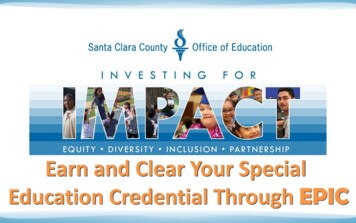
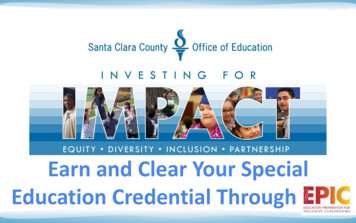
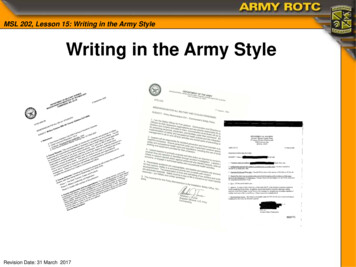
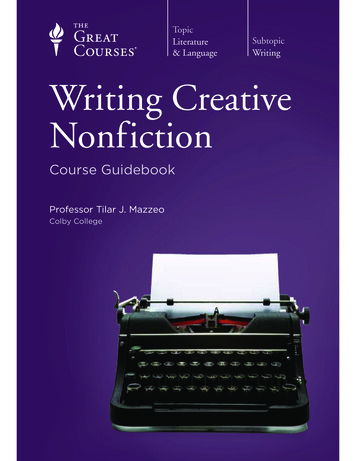
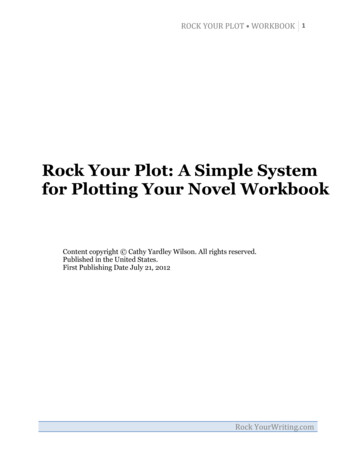
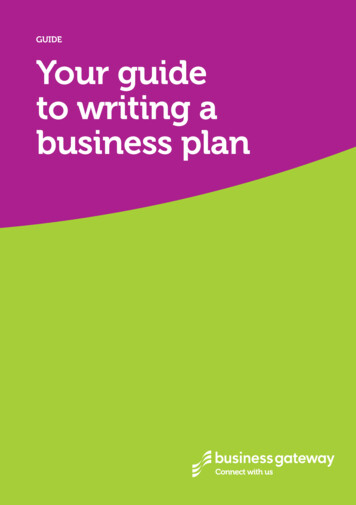
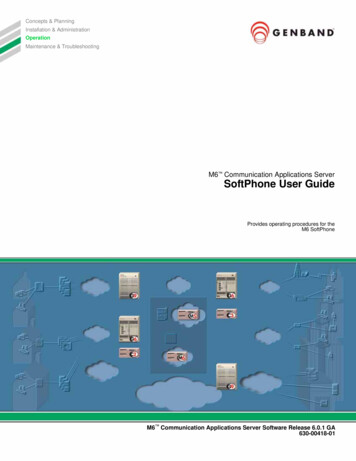
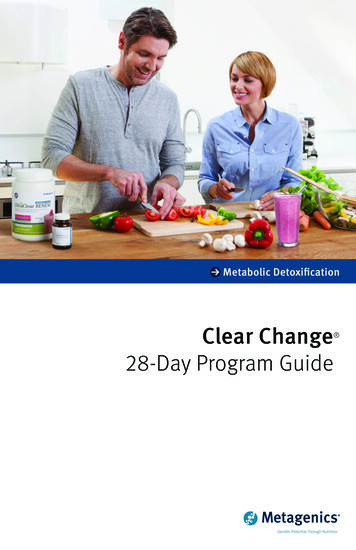
![Fluent Python : [clear, concise, and effective programming]](/img/1/799981060.jpg)

